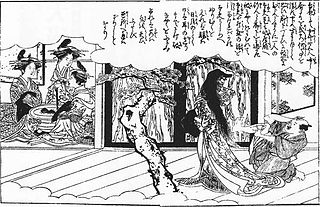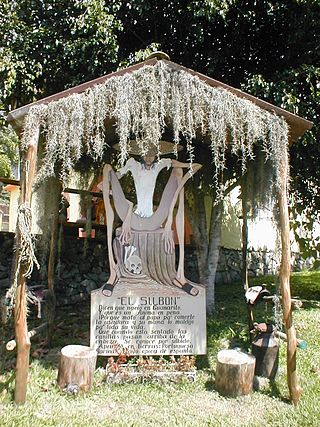Diné Bahaneʼ, is a Navajo creation story that describes the prehistoric emergence of the Navajo as a part of the Navajo religious beliefs. It centers on the area known as the Dinétah, the traditional homeland of the Navajo, and forms the basis of the traditional Navajo way of life and ceremony. Throughout the stories the importance of cardinal points and the number four are emphasized in multiple aspects.

La Llorona is a vengeful ghost in Mexican folklore who is said to roam near bodies of water mourning her children whom she drowned in a jealous rage after discovering her husband was cheating on her.

A changeling, also historically referred to as an auf or oaf, is a human-like creature found throughout much of European folklore. A changeling was a substitute left by a supernatural being on kidnapping a human being. Sometimes the changeling was a 'stock', more often the changeling was a supernatural being made magically to look like the kidnapped human. Supernatural beings blamed for stealing children included fairies, demons, trolls, nereids and many others. Usually, the kidnapped human was a child; but there were cases, particularly in Scandinavia and Ireland where adults were taken.

Latvian Lauma or Lithuanian Laumė, or Yotvingian Łauma is a fairy-like woodland spirit, and guardian spirit of orphans in Eastern Baltic mythology or Yotvingian mythology. Originally a sky spirit, her compassion for human suffering brought her to earth to share our fate.

The Cegua, La Sihuehuet or Siguanaba, Cigua or Siguanaba is a supernatural character from Central American folklore, though it can also be heard in Mexico. It is a shapeshifting spirit that typically takes the form of an attractive, long haired woman seen from behind. She lures men away into danger before revealing her face to be that of a horse or, alternatively, a skull.
The cadejo is a supernatural spirit that appears as a dog-shaped creature with blue eyes when it is calm and red eyes when it is attacking. It roams around isolated roads at night, according to Central American folklore of indigenous origin. There is a good white cadejo and an evil black cadejo. Both are spirits that appear at night to travelers: The white cadejo protects them from harm and danger during their journey, while the black cadejo tries to kill them. They usually appear in the form of a large, shaggy dog with burning red eyes and goat's hooves, although in some areas, they have more rough characteristics. According to the stories, many have tried to kill the black cadejo, but have failed and perished. It is said that if a cadejo is killed, it will smell terrible for several days, and then its body will disappear. Some Guatemalan and Salvadoran folklore also tells of a cadejo that protects drunk people against anyone who tries to rob or hurt them. When the cadejo is near, it is said to bring a strong goat-like smell. Turning one's back on the cadejo or speaking to it are said to induce insanity.

Kuchisake-onna is a malevolent figure in Japanese urban legends and folklore. Described as the malicious spirit, or onryō, of a woman, she partially covers her face with a mask or other item and carries a pair of scissors, a knife, or some other sharp object. She is most often described as having long, straight, black hair, pale skin, and otherwise being considered beautiful . She has been described as a contemporary yōkai.
The Child who came from an Egg or The Egg-Born Princess is an Estonian fairy tale, collected by Dr. Friedrich Reinhold Kreutzwald in Eestirahwa Ennemuistesed jutud.

A White Lady is a type of female ghost. She is typically dressed in a white dress or similar garment, reportedly seen in rural areas and associated with local legends of tragedy. White Lady legends are found in many countries around the world. Common to many of these legends is an accidental death, murder, or suicide, and the theme of loss, betrayed by a husband or fiancé, and unrequited love.

The Patasola or "single leg" is one of many legends in South American folklore about female monsters from the jungle, appearing to male hunters or loggers in the middle of the wilderness when they think about women. The Patasola appears in the form of a beautiful and seductive woman, often in the likeness of a loved one, who lures a man away from his companions deep into the jungle. There, the Patasola reveals her true, hideous appearance as a one-legged creature with ferocious vampire-like lust for human flesh and blood, attacking and devouring the flesh or sucking the blood of her victims.

Potiphar's wife is a figure in the Hebrew Bible and the Quran. She was the wife of Potiphar, the captain of Pharaoh's guard in the time of Jacob and his twelve sons. According to the Book of Genesis, she falsely accused Joseph of attempted rape after he rejected her sexual advances, resulting in his imprisonment.
Spearfinger, or U'tlun'ta', is a monster and witch in Cherokee legend, said to live along the eastern side of Tennessee and western part of North Carolina. U'tlun'ta is Cherokee for "the one with the pointed spear”. Her right forefinger resembles a spear or obsidian knife, which she uses to cut her victims. Her mouth is stained with blood from the livers she has eaten. She is also known as Nûñ'yunu'ï, which means "Stone-dress", for her stone-like skin. Often she clutches her right hand tightly, because she is hiding her heart and her only weak spot, which is her right palm.

Brooke Logan is a fictional character from The Bold and the Beautiful, an American soap opera on the CBS network. She has been portrayed by Katherine Kelly Lang since the series's debut in March 1987. The character is part of the original four central characters and actors. Over the years, she has developed into a business woman working at Forrester Creations and a mother to five children: Rick, Bridget, Hope, R.J. and Jack. Her character is described as having "emerged as the show's quintessential vixen, always in turmoil and forever symbolic of true love and destiny prevailing." The character has also had long-time rivalries with Stephanie Forrester and Taylor Hayes. In addition to Ridge, Brooke has also had marriages with Eric Forrester Ridge's father, Ridge's two half-brothers, Thorne Forrester and Nick Marone, her brother-in-law Bill Spencer, Jr., and several others, including marriages to Whip Jones and Grant Chambers.

The legend of The Twelve Sisters or The Twelve Ladies, known as Nang Sip Song (นางสิบสอง) or as Phra Rot Meri (พระรถเมรี) in Thai and រឿងភ្នំនាងកង្រី Puthisen Neang KongRei in Cambodia, is a Southeast Asian folktale, and also an apocryphal Jātaka Tale, the Rathasena Jātaka of the Paññāsa Jātaka collection. It is one of the stories of the previous lives of Buddha in which Rathasena, the son of one of the twelve women, is the bodhisattva.

Pob Pee Fah is a Thai ghost story, made as a TV series. Set partly in the 19th century, it shares some plot details with an earlier series, Jao Nang, which aired in 1990, and on which some observers believe it was based.

Erau is an Indonesian biennial cultural festival, taking place in the city of Tenggarong, Kutai Kartanegara, East Kalimantan. The word Erau is derived from the Kutai word eroh, meaning crowded, noisy, joyful.
María del Mar is a Venezuelan telenovela produced by Venevisión in 1978. An original story by veteran telenovela writer Delia Fiallo, it starred Chelo Rodríguez and Arnaldo André as the main protagonists with Hilda Carrero and Martín Lantigua as the antagonists.

In mythology and folklore, a vengeful ghost or vengeful spirit is said to be the spirit of a dead person who returns from the afterlife to seek revenge for a cruel, unnatural or unjust death. In certain cultures where funeral and burial or cremation ceremonies are important, such vengeful spirits may also be considered as unhappy ghosts of individuals who have not been given a proper funeral.

El Silbón is a legendary figure in Colombia and Venezuela, associated especially with Los Llanos region, usually described as a lost soul. The legend arose in the middle of the 19th century.













